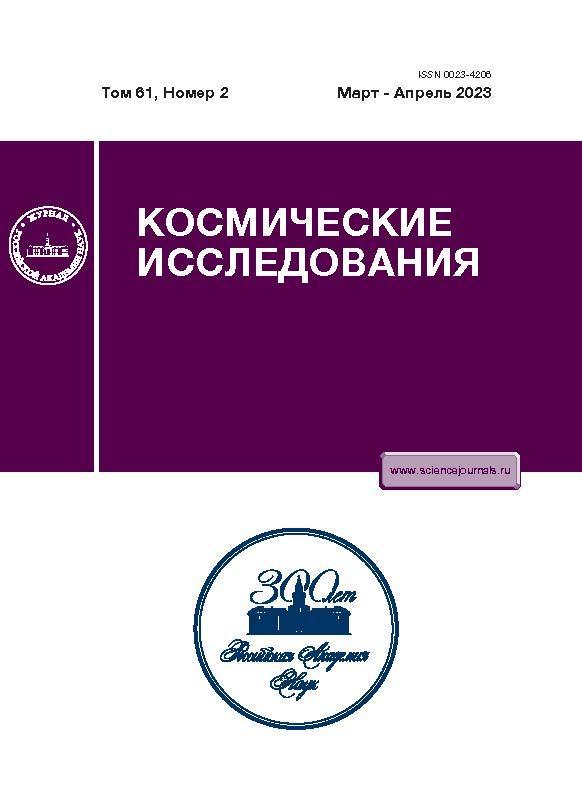Study of the Green Coronal Line with Altitude from Out-of-Eclipse Observations during Solar Cycle 24
- Authors: Guseva S.A.1, Shramko A.D.1
-
Affiliations:
- Kislovodsk Mountain Astronomical Station of Pulkovo Astronomical Observatory, Russian Academy of Sciences, Kislovodsk, Russia
- Issue: Vol 61, No 2 (2023)
- Pages: 124-133
- Section: Articles
- URL: https://ter-arkhiv.ru/0023-4206/article/view/672671
- DOI: https://doi.org/10.31857/S0023420622600180
- EDN: https://elibrary.ru/LTHWMK
- ID: 672671
Cite item
Abstract
The results of studies of the coronal emission line λ = 5303 Å (Fe XIV) for the period of solar cycle 24 are presented. The spectral data were obtained with an out-of-eclipse Lyot coronagraph at the Mountain Astronomical Station of the Pulkovo Observatory, Russian Academy of Sciences (near Kislovodsk). As a result of processing of out-of-eclipse observations, a database of three types of daily coronal maps of green line intensity I5303 was created with a height distribution h from 1R☉ to 1.38R☉ (R☉ is the radius of the Sun). Irregularities along the λ = 5303 Å line were found and identified, which were associated with the configuration of magnetic fields in the solar corona above active regions. The length of the green line from the position angle of the Sun was calculated. We have shown that the time distribution of the line length in the polar regions has two maxima, which coincide with the times of the reversal of the polar magnetic field on the Sun. The maximum values of the average length of the coronal line along the entire limb occur in 2012–2014. For different phases (the rise, the period of maximum, the decline, and the minimum solar activity) of this solar cycle and for different regions of solar activity, dependences of the height variations of the I5303 values were plotted and studied. The regression equations for these fitting curves are presented. The variation in I5303 with height for the polar regions is most likely determined by a logarithmic function, and the approximating trend curves for the remaining latitudinal zones are determined by a third-order power function.
About the authors
S. A. Guseva
Kislovodsk Mountain Astronomical Station of Pulkovo Astronomical Observatory, Russian Academy of Sciences, Kislovodsk, Russia
Email: a_shramko@inbox.ru
Россия, Кисловодск
A. D. Shramko
Kislovodsk Mountain Astronomical Station of Pulkovo Astronomical Observatory, Russian Academy of Sciences, Kislovodsk, Russia
Author for correspondence.
Email: a_shramko@inbox.ru
Россия, Кисловодск
References
- Lyot B. La couronne solaire étudiée en dehors des éclipses // Comptes rendus de l’Académie des Sciences. 1930. V. 191. P. 834–837.
- Edlén B. Die Deutung der Emissionsliniein in Spektrum der Sonnenkorona // Z. Astrophysik. 1943. V. 22. P. 30–64.
- Waldmeier M. Die Sonnenkorona. Basel: Birkhäuser, 1957. V. 2. 353 p.
- Гневышев М.Н., Гневышева Р.С. Начало регулярных наблюдений солнечной короны внезатмений // Бюл. Комиссии по исследованию Солнца. 1954. № 10. С. 60–62.
- Шкловский И.С. Физика солнечной короны. 2-е изд. М.: Гос. изд-во физ.-мат. лит., 1962. 516 с.
- Fisher R.R. λ 5303 Fe XIV density models of the inner solar corona // Solar Physics. 1978. V. 57. № 1. P. 119–128.
- Okamoto T. Latitude distribution of the green corona for the period 1951–1985 // Tokyo Astronomical Observatory Reprints. 1986. V. 20. № 4. P. 547–551.
- Sakurai T., Irie M., Imai H., Miyazaki H., Sykora J. Emission line intensities of the solar corona and sky brightness observed at Norikura: 1950–1997 // Publ. National Astronomical Observatory, Japan. 1999. V. 5. P. 121–137.
- Rybanský M., Minarovjech M., Rušin V. Evolution of the green corona in 1996–2002 // Solar Physics. 2003. V. 217. P. 109–118.
- Rušin V., Rybanský M., Minarovjech M. The 530.3 nm corona irradiance from 1939 to 2001 // Advances in Space Research. 2004. V. 34. P. 251–257.
- Гусева С.А. Долговременные циклические изменения структуры солнечной короны: дис. канд. физ.-мат. наук. СПб., 2013. 156 с.
- Rusin V. The Height Gradient of the Coronal Emission Line 5303 Å // Bull. Astronomical Inst. Czech Academy of Sciences. 1973. V. 24. № 3. P. 121–129.
- Тягун Н.Ф. Исследования взаимосвязи полуширина – интенсивность для линий излучения короны Fe XIV 5303, Fe X6374 и Са XV 5694 в зависимости от высоты // Солнечно-земная физика. 2004. № 6. С. 104–105.
- Singh J., Ichimoto K., Imai H., Sakurai T., Takeda A. Spectroscopic Studies of the solar corona I. Spatial variations in line parameters of green and red coronal lines // Publ. Astronomical Soc. Japan. 1999. V. 51. P. 269–273.
- Singh J., Sakurai T., Ichimoto K., Suematsa Y., Takeda A. Spectroscopic Studies of the Solar Corona II. Properties of Green and Red Emission Lines in Open and Closed Coronal Structure // Publ. Astronomical Soc., Japan. 2002. V. 54. P. 793–806.
- Гусева С.А., Шрамко А.Д. Исследование корональной линии 5303 Å на разной высоте от лимба Солнца в период спада солнечной активности // Тр. конф. “Физическая природа солнечной активности и прогнозирование ее геофизических проявлений”. ГАО РАН. СПб., 2007. С. 131–134.
- Guseva S.A. Continuous 60-Year Observations of the Spectral Solar Corona at the Mountain Astronomical Station of Pulkovo Observatory // Geomagnetism and Aeronomy. 2019. V. 59. № 7. P. 864–869.
- Гневышев М.Н. Техника и методика корональных наблюдений // Бюл. Международный геофизический год. 1959. С. 36–38.
- Costa A., Stenborg G. Characterization of Intensity Variations Along Fe XIV Coronal Loops — A Case Study // Solar Physics. 2004. V. 222. № 2. P. 229–245.
- Ким Гун-дер. Импульсы корональной активности // Тр. конф. “Солнечная активность как фактор космической погоды”. ГАО РАН. СПб., 2005. С. 403–404.
- Гусева С.А., Фатьянов М.П., Шрамко А.Д. Конфигурация гелиосферного слоя по синоптическим картам корональных лучей за 23-й, 24-й циклы солнечной активности // Геомагнетизм и аэрономия. 2015. Т. 55. № 3. С. 302–309.
Supplementary files















